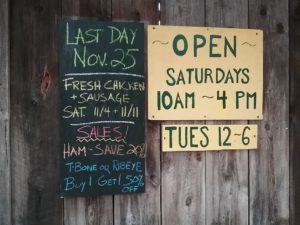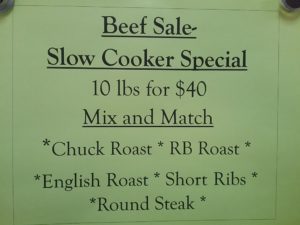Many farm-related businesses are seasonal. Our farm stand is open to the public from Memorial Day weekend through the end of November each year. It can be quite tricky to have enough inventory to have a nice selection of items for customers without being stuck with more than we need over the winter months.
In the past, we typically were able to use up leftover perishables. Any excess squash or other vegetables could provide supplemental food for our pigs. The meats left at the end of our final day would be what we ate over the winter until we began processing again in the spring. However, as our business grows, we process more meats than ever before. This also meant that this fall, our freezers had more meat than the two of us could possibly use as the number of farm stand days dwindled. It can be hard to discount the price we are accustomed to charging and take less for our hard work. But this also has to be weighed against not selling the item at all and having a situation where it may go to waste or ends up being given away.
When I run sales on our items, I take a look at our inventory and see what items I feel I need to move. This could be because I am trying to rotate inventory and sell what I have before I process more, or because I have a lot of that item. The obvious answer is to run a sale.

We advertise sales on the chalkboard outside the farm stand as well as inside and online.
There are several different ways we approach end-of-season sales. All would apply to sales any time of the year, too! Sometimes, it makes the most sense to offer a certain amount off the regular price- for example, $1.00/pound. This is the method I typically use for large things like a bone-in ham or a whole chicken. These are things that take up a lot of freezer room. These sales encourage folks to pick up one or two, but they are typically not going to lead to bulk purchases.
Another way to discount is to have a special that requires a purchase of more than one of the same item- Buy One Get One (BOGO) sales. Running a “buy one get one half off” sale is a good way to move things at a higher volume than simply discounting a percent off. Even if the price each works out to be the same, you’ll still sell more because people will be buying two or more at a time. As it gets closer to our closing date, if I am still overstocked with items I have as BOGO-half off, I will further reduce the sale to BOGO-free. This means I am discounting my product by 50%, so I don’t do it frequently, but it’s a great incentive to get customers to purchase something I’m overstocked on as winter closes in.
Bulk sales are another way to move larger quantities of an item. In past years, if I had a lot of ground beef I would offer it as a bulk sale. If regular price is $5.50/lb, I would run a special offering 5 pounds for $25. While I am only discounting $0.50 per pound, it was surprising how often people would buy 5 or 10 pounds simply because that was what was on sale. These types of sales help move larger quantities, often with little discount, because many people won’t do the math in their head.
This year, since I had more beef roasts than ground meat to move, I took a similar but slightly different approach. Late this fall, we had a miscommunication with our meat processor and ended up with more beef roasts and less ground beef than we had planned. I felt I was overstocked with chuck roasts, English roasts, bottom round roasts, round steak and short ribs. To encourage customers to buy those cuts, I ran something I called the “Slow Cooker Special”. I had a set price- 10 lb for $40- but let the customer mix and match from the 5 cuts. Some would opt for some of each cut, others would want 10 lbs of only one. It worked well because these cuts were closely priced, but the customers could customize. I do not believe the sale would have went over nearly as well if I had set it up where customers had to buy all 10 lbs of only one of those cuts or had to take some of all five.

Customers respond well to sales they can customize.
After you’ve put thought into how much you’re willing to discount your items, you need to make sure customers are aware of your sales. We advertise our meat prices on a large chalkboard at the farm stand as well as on our website. I make sure to leave the original price, them mark the sale price next to it in a bright color. This is more attractive and attention-grabbing than simply changing a price from $5/lb to $4/lb. Making folks feel like they are getting a great deal is important! I also printed the current sales on bright pieces of paper and posted them in various places around the farm stand. Customers don’t always notice things that may seem obvious to us as shop owners, so don’t be afraid to post duplicates. I posted the current sales on our Facebook page too, and found that the likes and shares actually resulted in people stopping by just for the meat sales. Getting them in the door often meant they found a few other things while shopping as well.
Well-managed sales mean that you are still getting a price you find acceptable for your hard work. It also means that your customers think they are getting a good deal. With a little planning you can do both, while moving excess inventory and boosting your bottom line!










